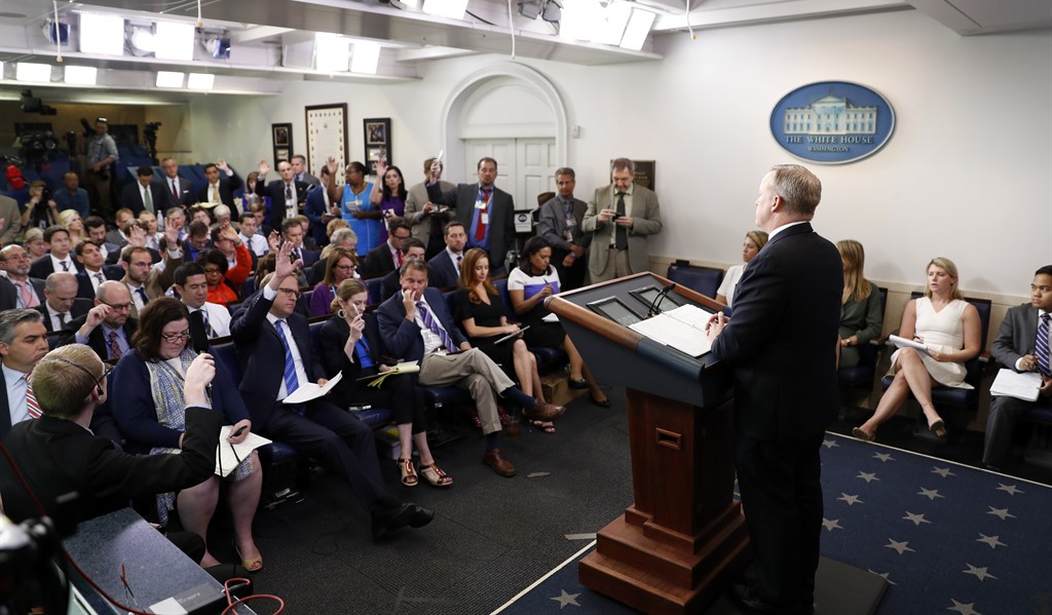Ari Fleischer and Mike McCurry, each a former press secretary, say yes. I don’t get it.
So, what to do differently? First, we recommend that President-elect Trump keep the press briefing, but no longer make it a live televised event. The briefing today has become an occasion for too much posturing on both sides of the camera. The president’s spokesman should and must be available for questioning, especially on those days when the president’s schedule does not include a public appearance.
But a simple change could make a difference. If the briefing is “embargoed” until its conclusion, it will become just one of several raw ingredients that journalists can use to prepare their reports on the work of the president and the White House. It would instantly become a toned-down briefing, and reporters would use the information from the briefing and test it against other sources as they prepare coverage. It would not be a “news event” in and of itself. An exception could be made by the White House if there is a major compelling event that demands live coverage, but the emphasis of the briefing should be on gathering and delivering real content. Too much of the briefing today is a game of “gotcha” and “what did the president do wrong?” A better model would focus on facts and substance.
I don’t care if the briefing goes off-camera entirely but lots of reporters do, insisting that in a video age there’s no substitute for actually seeing how Sean Spicer or Sarah Huckabee Sanders fields a question. The problem is that video encourages grandstanding by both the press corps and the press secretary. Who knows how that dopey exchange yesterday between Sanders and the reporter from Playboy would have played out if there was no viewing audience for each to pander to. The Supreme Court has banned cameras for decades for precisely this reason, because they suspect lawyers will start speechifying for the home audience instead of engaging with the justices’ questions if oral arguments are carried live. Fleischer and McCurry are looking for the middle ground — give the media the video it craves but take away the incentive to grandstand. Solution: Tape delay.
Again, I don’t get it. The idea, I guess, is that if the briefing is carried live then reporters would know that any grandstanding they do won’t *necessarily* be seen by a large TV audience. It’ll be edited out afterward, with cable news networks probably choosing to show only the choicest bits from the briefing. Two problems, though. One: Tape delay would do nothing to discourage grandstanding by the press secretary. If anything, the “choicest bits” would quickly become a synonym for “the most contentious or theatrical moments.” Spicer and Sanders could still ensure coverage of a key talking point by ramping up the drama around it. Two: Perversely, tape delay could encourage grandstanding by the press. As it is, by carrying the briefing live, each network knows that if any drama occurs — even if a rival network’s correspondent is responsible for it — they’ll be able to air it as it happens. Once the shift is made to tape delay, the calculus changes. If, for instance, CNN’s reporter gets into a back and forth with Spicer, do Fox’s editors choose to air that exchange and risk promoting the competition (especially if the exchange isn’t very newsworthy) or do they edit it out of their airing of the briefing? The only way for each network to ensure daily drama without having to showcase questions asked by correspondents from other networks is to make sure that their own correspondent provides a little drama in challenging Spicer. The result, potentially, is even more grandstanding than there is now.
I do like this idea:
We recommend a revolving group of reporters be assigned to those seats. For instance, on Mondays, it could be the current White House press corps. On Tuesdays, it could be the business press, including online media. On Wednesdays, it could be foreign journalists. On Thursdays, the seats would go to liberal and conservative dot-com outlets. We like the idea of Think Progress and Breitbart sitting next to each other. On Fridays, attendees could be Washington-based reporters from newspapers and websites around the country. But a daily briefing should be a mainstay.
Why would Trump go for it, though? He wants fewer questions for his comms team, not more. Start bringing in specialty press, like business reporters or foreign correspondents, and Spicer’s deer-in-the-headlights look would be more intense than it is now. And how do you think tape delay’s going to discourage Think Progress from asking Spicer the most outlandish gotcha questions it can think of? An angry exchange with Trump’s press secretary that goes viral is worth hard dollars to any liberal outlet capable of pulling it off, just as an angry exchange between a conservative reporter and Josh Earnest would have earned many page views for a righty site. If you’re giving Trump serious advice on how to reform the press briefing, you need to make it less challenging and/or less transparent for him, which is what he craves. The tape-delay idea arguably does that. Opening up the briefing to more hostile or more expert media outlets doesn’t.
Here’s Walter Isaacson, the former CEO of CNN, arguing that fewer on-camera briefings would be a good thing.







Join the conversation as a VIP Member